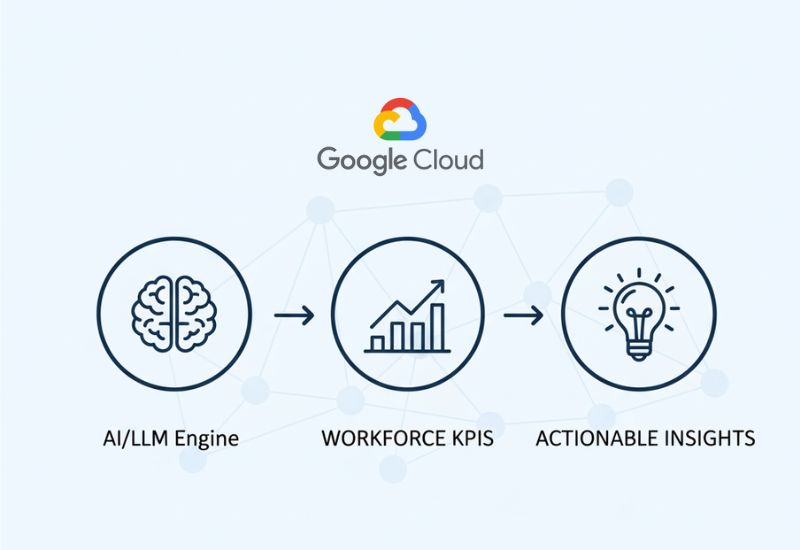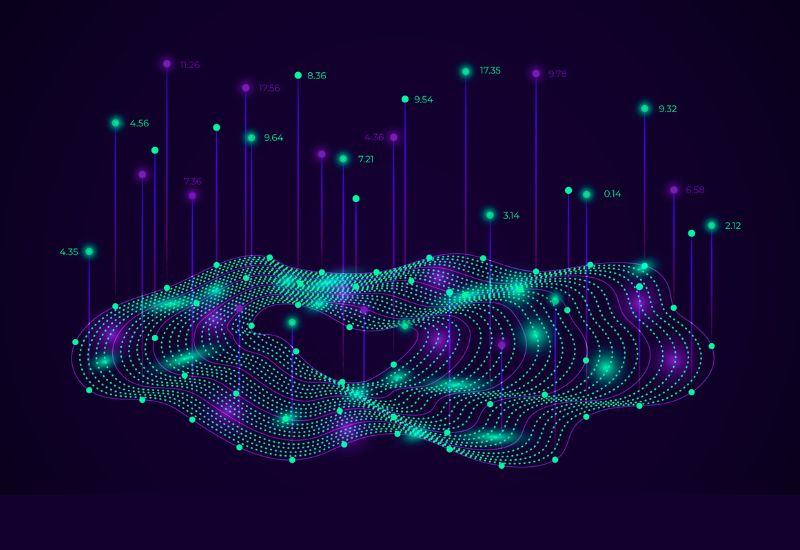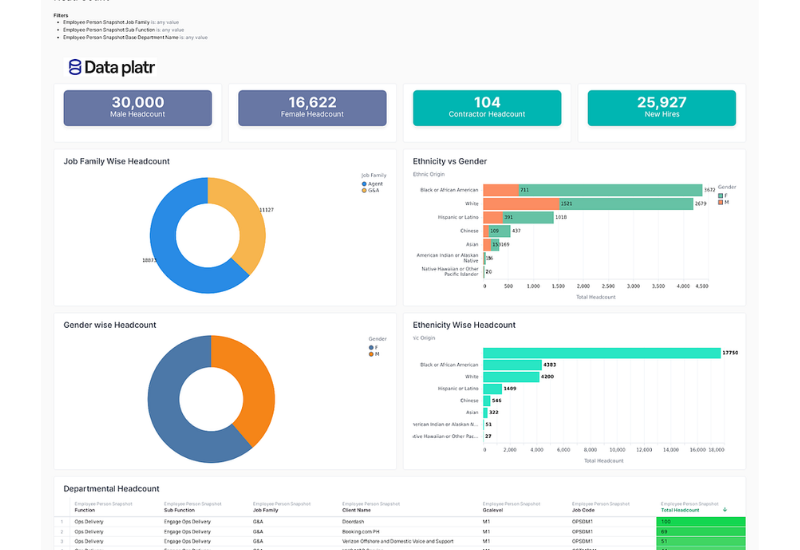What is data science?
Data science is the study of data to extract meaningful insights for business. It is an approach that combines principles and practices from the fields of mathematics, statistics, artificial intelligence, and computer engineering to analyze and to drive business decision-making. This analysis helps data scientists to ask and answer questions like what happened, why it happened, what will happen, and what can be done with the results.
How Data Science Works
The process typically follows these stages:
- Data Collection/Ingestion: Gathering raw data from sources like databases, IoT, logs, APIs.
- Data Cleaning & Preparation: Handling missing values, duplicates, transformation via ETL processes.
- Exploratory Data Analysis (EDA): Identifying patterns, biases, ranges in data.
- Modeling & Analytics: Building models for descriptive, diagnostic, predictive, and prescriptive analytics.
- Communication: Visualizing and reporting insights for stakeholders using tools like Python, R, BI platforms.
- Deployment & Automation: Operationalizing models and enabling continuous improvement.
AI's Role in Data Science
Artificial Intelligence (AI), particularly machine learning, plays a central role in modern data by enhancing both efficiency and capability. It automates repetitive tasks such as report generation and narrative summarization, freeing data scientists to focus on higher-value analysis. AI also powers predictive and prescriptive analytics using advanced techniques like neural networks and recommendation engines, enabling more accurate forecasting and decision making. By integrating AI in data science workflows, organizations can achieve faster, more scalable insights, ultimately driving better outcomes and improving the speed at which data-driven strategies are executed.
Difference Between Data Science and Data Analytics
- Scope – Data science is broader, covering data collection, processing, modeling, and prediction, while data analytics focuses mainly on analyzing existing datasets to find trends and patterns.
- Goal – It aims to predict future outcomes and build models; data analytics aims to explain historical trends and understand why they occurred.
- Techniques – It often uses advanced machine learning and AI models; data analytics relies more on statistical methods, BI tools, and visualization.
- Data Type – It works with structured, semi-structured, and unstructured data; data analytics usually focuses on structured and semi-structured data.
- Outcome – It delivers predictive and prescriptive insights; data analytics produces descriptive and diagnostic insights.
Difference Between Data Science and Machine Learning
- Definition – Data science is an umbrella field that includes data engineering, analytics, visualization, and modeling; machine learning is a subset focused on algorithms that learn from data.
- Purpose – It answers broader business questions and communicates insights; machine learning’s purpose is to create models that improve automatically over time.
- Process Involvement – It covers the full data lifecycle; machine learning is part of the modeling stage within that lifecycle.
- Skills Required – Data scientists need domain expertise, statistics, programming, visualization, and ML skills; machine learning engineers focus more on algorithm design and optimization.
- Output – It outputs insights and strategies; machine learning outputs predictive models and automated decision-making systems.
What is Data Science used for?
The uses of data are vast, transforming industries like retail, healthcare, and finance. By turning raw data into actionable insights, it helps businesses make smarter decisions, boost efficiency, and stay competitive.
- Descriptive Analysis - It helps in accurately displaying data points for patterns that may appear that satisfy all of the data’s requirements. In other words, it involves organizing, ordering, and manipulating data to produce information that is insightful about the supplied data. It also involves converting raw data into a form that will make it simple to grasp and interpret.
- Predictive Analysis - It is the process of using historical data along with various techniques like data mining, statistical modeling, and machine learning to forecast future results. Utilizing trends in this data, businesses use predictive analytics to spot dangers and opportunities.
- Diagnostic Analysis - It is an in-depth examination to understand why something happened. Techniques like drill-down, data discovery, data mining, and correlations are used to describe it. Multiple data operations and transformations may be performed on a given data set to discover unique patterns in each of these techniques.
- Prescriptive Analysis - Prescriptive analysis advances the use of predictive data. It foresees what is most likely to occur and offers the best course of action for dealing with that result. It can assess the probable effects of various decisions and suggest the optimal course of action. It makes use of machine learning recommendation engines, complicated event processing, neural networks, simulation, graph analysis, and simulation.
Why Data Science Is Important
Organizations today are flooded with massive volumes of data, and data science plays a critical role in deriving meaningful insights from this information. It empowers businesses to understand customers better and make strategic, data-driven decisions across industries such as marketing, healthcare, finance, and public services. With its growing importance, the global market is projected to expand at a remarkable CAGR of 16.4%, reaching an estimated value of $378.7 billion by 2030.
What is the Data Science process?
- Obtaining the data - The first step is to identify what type of data needs to be analyzed, and this data needs to be exported to an excel or a CSV file.
- Scrubbing the data - It is essential because before you can read the data, you must ensure it is in a perfectly readable state, without any mistakes, with no missing or wrong values.
- Exploratory Analysis - Analyzing the data is done by visualizing the data in various ways and identifying patterns to spot anything out of the ordinary. To analyze the data, you must have excellent attention to detail to identify if anything is out of place.
- Modeling or Machine Learning - A data engineer or scientist writes down instructions for the Machine Learning algorithm to follow based on the Data that has to be analyzed. The algorithm iteratively uses these instructions to come up with the correct output.
- Interpreting the data - In this step, you uncover your findings and present them to the organization. The most critical skill in this would be your ability to explain your results.
Types of Data in Data Science
Understanding different data types is essential because each requires specific analysis techniques and tools. The main types include:
- Nominal Data – Categorical data without any inherent order, such as gender, colors, or blood types. These are used mainly for classification and labeling.
- Ordinal Data – Categorical data with a defined order or ranking, like education levels, customer satisfaction ratings, or competition positions.
- Discrete Data – Numeric data that can take only specific values, such as the number of sales, employees, or website visits.
- Continuous Data – Numeric data that can take any value within a range, like temperature, height, or revenue.
- Binary Data – Data with only two possible outcomes (yes/no, true/false, pass/fail), often used in classification problems.
Applications of Data Science
Data science’s versatility allows it to reshape industries, drive innovation, and solve complex problems. Here are some unique, impactful applications:
- Supply Chain Optimization - Data models help businesses predict demand fluctuations, optimize inventory levels, and streamline logistics. By analyzing historical sales data, shipping times, and seasonal patterns, companies can reduce delays, cut storage costs, and enhance delivery speed. This results in leaner operations and better customer satisfaction.
- Energy Consumption Forecasting - Utility companies use to forecast energy demand, identify usage patterns, and detect anomalies in consumption. These insights help in grid management, renewable energy integration, and preventing outages. Predictive analytics also support sustainability efforts by minimizing waste and improving resource allocation.
- Agriculture and Crop Management - Farmers use satellite imagery, IoT sensors, and climate data to predict crop yields, detect plant diseases early, and optimize irrigation. It enables precision agriculture, ensuring better productivity and reduced environmental impact. This is particularly valuable in tackling food security challenges.
- Sports Performance Analysis - Sports teams use player statistics, biomechanical data, and video analytics to improve performance and reduce injury risks. It also assists in game strategy planning by analyzing opponents’ patterns. It’s not just for professionals—fitness apps use similar techniques to personalize workout plans.
- Urban Planning and Smart Cities - City planners apply to analyze traffic flows, pollution levels, and population growth. These insights support better infrastructure planning, waste management, and emergency services deployment. In smart cities, real-time data enables adaptive traffic control and improved public safety.
Benefits of Data Science in Business
- Turning Data into Insights - It transforms raw, unstructured, and structured data into clear, actionable insights that guide business strategy. By identifying patterns, trends, and correlations, organizations can make informed decisions that directly impact growth. This shift from guesswork to evidence-based decision-making leads to measurable improvements in performance and profitability.
-
Enhanced Customer Understanding -
Through customer behavior analysis, businesses can uncover hidden preferences, buying habits, and engagement patterns. This allows for highly targeted marketing campaigns, tailored product recommendations, and better service delivery. The result is stronger customer relationships, improved loyalty, and higher lifetime value per customer.
- Operational Efficiency - By analyzing workflow data, It can pinpoint inefficiencies, resource waste, and process bottlenecks. Businesses can then optimize operations, automate repetitive tasks, and reduce operational costs. This efficiency boost not only saves time and money but also allows teams to focus on higher-value, strategic activities.
- Risk Management - It equips organizations with tools to identify and assess risks before they escalate. Predictive models can detect fraud, forecast market volatility, and highlight operational vulnerabilities. Proactive risk management minimizes financial loss, protects brand reputation, and ensures long-term business stability.
- Competitive Advantage - Businesses that effectively use can respond faster to market changes, anticipate customer needs, and innovate ahead of competitors. Real-time analytics enable quick adaptation to trends and threats. Over time, this data-driven agility becomes a key differentiator in highly competitive industries.
Common Challenges in Data Science
Despite its benefits, data science comes with its own set of obstacles:
- Data Availability & Quality – Incomplete, inconsistent, or inaccurate data can lead to unreliable insights.
- Data Integration Issues – Combining data from multiple sources can be complex due to differing formats and structures.
- Scalability – Managing and processing massive datasets requires significant computing resources.
- Talent Shortage – Finding skilled data scientists with domain expertise is often challenging.
- Model Interpretability – Complex AI and ML models can be difficult to explain to stakeholders, impacting trust and adoption.
Conclusion
Data science is the backbone of innovation and competitive advantage in today’s data-driven world. By combining statistics, programming, Gen AI, and domain expertise, it empowers organizations to uncover hidden patterns, predict future trends, and make informed decisions with confidence.
Contact us at [email protected] or Book time with me to organize a 100%-free, no-obligation call
Follow us on LinkedIn for more interesting updates.



























